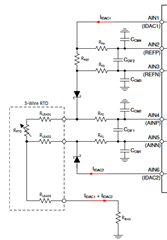Hello,
I'm trying to use the ADS1263 for a 3-wire RTD measurement with the same circuit as proposed in the component's datasheet as a typical application (image below).
The conversion value does move accordingly with temperature variations, however the conversion value doesn't match neither the measured resistances nor measured voltages of the active circuit.

I'm using a reference resistor with nominal value Rref=8kΩ and a platinum RTD with Rrtd=500Ω at 0°C. Measuring the actual resistances I found Rref=7.967kΩ and Rrtd=544Ω.
As I'm using a PGA gain of 8, I expect a conversion C=(Rrtd*8/Rref)*2^32, which should give me a conversion of roughly 0x8BXXXXXX. However the what I actually get from the ADS is 0x38XXXXXX.
I also measured Vref=1.967V and Vrtd=0.135V, which seem to confirm the calculations above.
The ADS register configuration is as follows:
reg_power = 0x01
reg_interface = 0x02
reg_mode0 = 0x30
reg_mode1 = 0x80
reg_mode2 = 0x35
reg_inpmux = 0x45
reg_idacmux = 0x61
reg_idacmag = 0x33
reg_refmux = 0x22
Before starting the acquisition I set reg_inpmux = 0x23 perform a full-scale calibration.
I have tried playing around with many settings but I cannot figure out what the issue is.
Would anybody have an idea? Thanks in advance.



